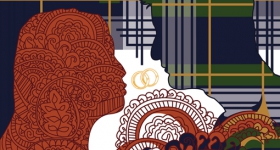Photographer Seng Chen
The Holy Grail, The Loch Ness Monster, The Asian American Doll. Do these exist? At times, it’s easier to believe in the first two myths than the last.
If Asian Americans are still disproportionately represented in the mainstream media, what are the chances they’d be poured, hot, into a mold and immortalized in plastic?
The Brief
Asian American dolls entered the American market as early as the ’70s, with the introduction of the grass-skirted Hawaiian Barbie in 1978 and a Fu Manchu-bearded Ming the Merciless, the enemy of the comic hero Flash Gordon, in 1979. Three years later, Larry Hama, a Japanese American artist, revived the GI Joe All-American Hero comic series, and created such memorable action figures as the 442nd Infantry Nisei soldier. In 1996, Hideo Nomo became the first Asian sports figure ever cast in plastic.
If toys help form one’s identity, what are the toys available in 2005 saying to Asian Pacific American children?
The Mission
Go undercover to an international toy behemoth and find the following in Asian American characters: a baby doll, a soft doll, a fashion doll and an action-figure doll.
The Scene of the Investigation
Toy Store, San Francisco. Crackling, fluorescent lights. Multi-ethnic personnel. At least 70 percent of the customers are Asian Pacific American families.
Case #1: Baby Dolls
To solve any case, you’ve got to start at the beginning. In this case, baby dolls aimed at children as young as 3 years old. First step: Locate an Asian Fisher-Price Little Mommy Doll, available with “adorable sleeper and bib with matching headband.”
Evidence: Every baby doll lining both sides of the aisle was white with blonde hair fluff and blue eyes or African American with dark hair fluff and dark eyes. Aside from these, there was one brown haired, lighter-skinned brown doll haphazardly thrown into an unmarked box in the sale section whose origins were unknown.
Notes to Headquarters: To prevent toddlers from attempting to jerry-rig an APA baby doll with a home hair-dye kit, this intrepid reporter wishes the store would carry the sleepy-eyed, pink-cheeked and vanilla-scented Yang, from Corolle Calin’s My First Doll collection. (www.corolledolls.com) With a face that looks real and distinct, Corolle fulfills its promise to help little girls grow up in a “wondrous world where she can let her imagination run free”…especially from stereotypes.
Case #1: SOFT DOLLS
Sharing the toddler age bracket with baby dolls are soft dolls. After receiving an unconfirmed tip that Cabbage Patch Kids once released a Cabbage Patch Chinese New Year doll, a prime directive for the day’s doll hunt was to locate the latest Asian Cabbage Patch—Asian Doll with Pink Satin Pajamas, afro-resplendent Asian Girl with Black Hair, Asian Princess Doll with Pet (a furry shih tzu), or, dreamily, the Asian Pink Ballerina with star crown and tutu.
Evidence: No Asian dolls were found, although the outfit for the Caucasian Cabbage Patch Sleep Over Collection Emily doll made it a close call: red and gold silk brocade mandarin-style pajamas with frog clasps and puffy panda bear slippers.
Notes to Headquarters: Further investigation reveals soft dolls can have both style and substance, such as the Language Little dolls’ Young Hee, a doll that speaks both Korean and English with just a press of her hand or knee. (www.languagelittles.com) Sporting a pink velvet vest and iridescent skirt, bilingual Young Hee will happily share with her playmates her love of biking, swimming or painting in both languages—a perfect playmate for a budding international crime solver.
Case #3: Fashion Dolls
All children dream of growing up, which is where the more mature dolls, such as Barbie or Bratz, come into play for children 6 and older. Mattel, while memorably refusing to create an Asian American Barbie for President doll in 2000, has an extensive history with perkily-tan and skimpily-clad Asian American dolls: Hawaiian Barbie, Polynesian Barbie, Tropical Miko, Island Fun Miko, Beach Blast Miko, Hawaiian Fun Kira, Wet n’ Wild Kira, and Tropical Splash Kira, among others. MGA Entertainment’s Bratz, introduced in 2001, countered Barbie’s curvaceous figure with oversized lips and an equally oversized wardrobe. Mission: Find any Asian Barbie or Bratz, and give her a towel to cover up.
Evidence: While APAs may not be very visible as baby or soft dolls, they are highly desirable as they mature into fuller figures—literally. Barbie’s Cali Girl Lea showcased both a coconut-scented tan, a bottle of SPF 45 sunscreen, and, of course, bikini bottoms. Holding numerous shopping bags complete with sold tags, Bratz’ Kumi, from the shopping-oriented Oh La La Collection, apparently preferred to shop the Parisian couture houses in a revealing mini-skirt and tiny crop top emblazoned with “I Love Paris.” A special bonus: Mattel’s Teen Trends Eitan, a male APA doll nicknamed “Dragon,” comes with a huge dragon on his shirt, flip flops, bead choker and the ubiquitous tan.
Notes to Headquarters: Immediately begin campaign for the comeback of the Get Set Club’s GFive Dolls, which is no longer in production. Conceived in 2000 from the conviction that what children play with influences their thought and development, the GFive Dolls intelligently rallied against “providing pink pre-fabricated prescriptions for play” by shunning fashion accessories for career-based playsets (artist, journalist, small business owner and scientist). The GFive’s Asian American Gia may have had the stereotypical long black hair, but she also was running for Secretary of the Treasury.
Case #4: Action Figure Dolls
Dolls aren’t just for girls, so it was important to search for male representation. Mattel’s flip-flop wearing Eitan doll aside, initial thoughts of looking for a male Asian American action figure doll (probably designed by non-Asian Americans) was haunted by the not-so-serious question: Would they give him a big gun or little gun?
Imagine the surprise when it was discovered that the most recent line of GI Joe comic books and characters (1980s–1990s) was created by an Asian American male who defied stereotypes in both his life and his creations. With the current war-focused climate, would it be easy to find an Asian American male action figure?
Evidence: Muscles and weaponry abound in the military toy section, but the only Asian action figure available was not a hero, but another villain—specifically, Feudal Shredder from the Teenage Mutant Ninja Turtle Enemies line. Although supposedly from 11th century Japan, the toy looked mysteriously like a Caucasian with overgrown sideburns and a constipated expression … probably the result of the massive weight of his “authentic” weaponry: the yuroi (armor) and kabuto (helmet) forged of “unearthly metals” and fitted with “deadly blades.” Although evil, with “unparalleled power and ambition,” the toy was also made to “crumple in defeat!” with a touch of a button. In fact, the toymakers thoughtfully enabled the figure to reset, so little children can make this evil samurai crumple in defeat until their thumbs go numb.
Notes to headquarters: Gift all potentially thumb-happy children with an Asian American action figure who doesn’t engage in martial arts, isn’t an evil villain, an animal in a ninja suit, an explosives ordnance specialist (like GI Joe’s Tunnel Rat), or Star Trek’s Captain Sulu.
A fellow investigator, Peter Chen, has logged an impressive case file on Asian American action figures after he couldn’t find
any Asian American toys on the web. Follow up on his quest at: geocities.com/Tokyo/Shrine/1275/menu.htm
INVESTIGATION STATUS: OPEN
The usual APA stereotypes made an appearance during this investigation: the sensual female and the evil ninja warrior.
The select few that have made it to the local chain store all seem to share the tans and bad eye makeup reminiscent of the fake-eyelid creases inflicted upon unsuspecting East Asian women by makeup counter saleswomen, giddy with the power of brown eye shadow.
However, invisibility comes in layers. What are in public view may be shopping bags, Dragon nicknames, and “unearthly” and “evil” martial arts skills. But underneath this layer, revealed by a few keystrokes, is the multi-hued face of Asian American toy culture on the web: a bilingual doll, an APA All-American Hero, a baby doll that looks like the children who play with them.
Great cases begin with a myth and a good lead. Asian American dolls exist, but they are elusive. These four cases, and many more involving the presence of Asian Americans in popular culture and commerce, are still open for investigation.









Comments